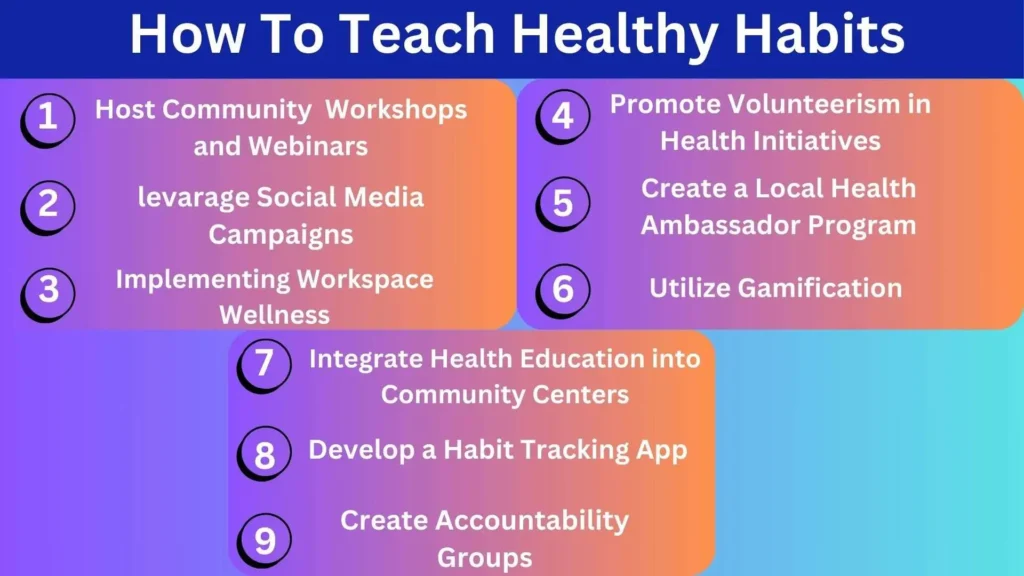Healthy habits are the foundation of a long, kinetic, and fulfilling life. They consist of various practices that promote physical, mental, and emotional well-being. These habits include regular exercise, balanced nutrition, adequate sleep, and effective stress management.
Building and maintaining healthy habits can significantly increase mental clarity and reduce the risk of chronic diseases to improve overall quality of life.
Table of Contents
How Does Teaching Healthy Habits Impact Us?
Healthy habits have a great impact on our overall well-being. Teaching good habits can help individuals build these habits, which in turn can benefit them in the following ways.
- Physically, they boost the immune system, improve cardiovascular health, and increase energy levels.
- Mentally, they reduce the risk of anxiety and depression, enhance cognitive function, and foster a positive outlook on life.
- Emotionally, healthy habits contribute to greater self-esteem and resilience. These habits enable us to cope better with life’s challenges.
By integrating good healthy habits into daily routines, people can experience improved longevity and a higher standard of living.
9 Practical Ways to Teach Healthy Habits
The best ways to teach good habits include the following:

1. Host Community Workshops and Webinars to Teach Healthy Habits
Hosting community workshops and webinars is an excellent way to teach healthy habits to a broad audience. These interactive sessions can cover various health topics, including nutrition, fitness, and mental well-being, making them highly versatile and beneficial for different demographics.
Engaging content is key to teaching good habits through workshops and webinars. Organizing sessions on essential topics like balanced diets, effective exercise routines, and attaining mindfulness in personal habits gives participants the knowledge they need to make healthier choices.
These workshops can be organized to address the specific needs of different groups, such as children, adults, or school communities.
Moreover, involving parents and teachers in these sessions can create a supportive environment that reinforces healthy habits at home and school.
Teaching healthy habits to adults can be particularly effective through webinars. Busy schedules often make it challenging for adults to attend in-person sessions, but webinars offer the flexibility to participate from anywhere. Inviting experts to provide practical advice and answer questions ensures that the information is credible and tailored to the participant’s needs.
By hosting community workshops and webinars, you create a platform for ongoing education and support, making it easier for all of us to adopt and maintain healthy habits. This approach addresses the immediate needs of different demographics and fosters a community-wide culture of health and well-being.
2. Leverage Social Media Campaigns to Teach Healthy Habits
Leveraging social media campaigns is a powerful and modern way to teach good habits to a broad audience. Platforms like Facebook, Instagram, X, and TikTok are ideal for sharing tips, success stories, and challenges related to healthy habits, reaching people of all ages and backgrounds.
Infographics are an excellent tool for this. They present information visually, making it easier to understand and remember. For example, infographics showing the benefits of eating fruits and vegetables can encourage people to incorporate more of these into their diets.
Teaching children good habits can be particularly effective through social media. Children and teenagers are highly active on these platforms. By creating fun and educational content, such as short videos demonstrating easy exercises or healthy snack recipes, you can capture their attention and inspire them to adopt these habits.
Creating a variety of content types is critical to keeping your audience engaged. Live Q&A sessions can be compelling, allowing followers to ask health-related questions in real-time and receive expert advice. This interactive approach educates and builds a sense of community and support.
By leveraging social media campaigns, you can teach healthy habits in a way that is accessible, engaging, and far-reaching. This method provides valuable information and encourages community commitment to health and well-being.
3. Implementing workplace wellness
Implementing workplace wellness programs is a highly effective strategy for teaching healthy habits and fostering a culture of well-being among employees. There are many strategies to adopt. For example
Introducing Health-Focused Initiatives
Start by creating engaging fitness challenges that motivate employees to be active. These can range from step-count competitions to team sports events. Promote these challenges on your company’s internal communication platforms and social media channels to boost participation and visibility.
Stress Management Workshops
We should manage stress effectively becuase Stress management is important to maintain mental health. Offer workshops that teach techniques such as mindfulness, meditation, and yoga. These workshops not only help employees manage stress but also improve overall productivity.
Offering Incentives
Incentives are powerful motivators. Provide gym memberships, healthy snacks, and wellness days to encourage employees to adopt healthier lifestyles. Promote these benefits on your company’s career page to attract health-conscious talent.
Creating a Health-Focused Culture
Fostering a culture that prioritizes health requires ongoing effort. Regularly update your social accounts with content related to your wellness programs. Use a mix of blog posts, images, videos, and infographics to keep your audience engaged.
By implementing these strategies, you can effectively teach healthy habits and improve well-being.
4. Promote Volunteerism in Health Initiatives
Promoting volunteerism in health initiatives is a powerful way to teach healthy habits to various demographics. Encouraging community members to volunteer in health-related events and activities develops a sense of responsibility. It also increases people’s involvement while providing practical experiences reinforcing healthy living.
Teaching healthy habits through volunteerism starts with organizing diverse health-related events. Clean-up drives, health fairs, and charity runs benefit the community and promote physical activity and social interaction. These events can teach participants the importance of maintaining a healthy environment and an active lifestyle.
How to teach good habits to children can be significantly enhanced by involving them in volunteer activities. Children can participate in clean-up drives to learn about environmental health or help at health fairs to understand the importance of wellness and community service.
Volunteerism can be integrated into schools by incorporating community service projects into the curriculum. Schools can organize events like health fairs, where students can volunteer to set up booths, provide information, or assist in organizing activities.
Charity runs can be organized as school events, encouraging students to participate and raise awareness about physical fitness and health issues. These activities provide practical, hands-on learning experiences that reinforce the importance of health and community involvement.
Encouraging volunteerism in health initiatives creates opportunities for individuals to learn and practice healthy habits in a community-oriented setting.
5. Create a Local Health Ambassador Program
Creating a Local Health Ambassador Program is an excellent strategy for teaching healthy habits across various age groups and settings.
Start by training dedicated volunteers to become health ambassadors. These ambassadors should be well-versed in promoting healthy habits and equipped with resources to educate their communities. Ambassadors can lead by example, showing the benefits of building exercise habits, balanced diets, and stress management techniques.
Health ambassadors can play a vital role in teaching children good habits. They can organize fun, interactive workshops in schools and community centers, focusing on the importance of physical activity and nutrition. Activities like sports, cooking classes, and gardening projects can make learning about health enjoyable for kids.
Student ambassadors for nutrients can conduct regular sessions on topics like healthy eating, the benefits of exercise, and mental well-being. These ambassadors can also lead health fairs and fitness challenges in colleges and schools. Teaching good habits in colleges and schools is necessary because 95% of students fail to eat healthy food.
6. Utilize Gamification to Teach Healthy Habits
Utilizing gamification is an innovative and engaging method to teach healthy habits. By incorporating game-like elements such as challenges, leaderboards, and rewards, you can make learning about health fun and motivating, encouraging sustained participation and commitment.
Gamification starts with creating engaging challenges. These can be tailored to different health goals, such as daily step counts, water intake, or balanced meals. Participants can track their progress and complete challenges to earn points or badges, making the journey towards healthier habits more interactive and enjoyable.
Teaching good habits to children can be particularly effective with gamified elements. Children naturally gravitate towards games and competition. By introducing challenges that encourage physical activity, such as a “30-Day Jump Rope Challenge,” or healthy eating, like “Try a New Vegetable Every Week,” you can capture their interest and motivate them to adopt these habits.
Leaderboards can foster friendly competition, while rewards like stickers, certificates, or small prizes can provide additional incentives.
Teaching healthy habits to adults can also benefit significantly from gamification. Adults often respond well to structured goals and tangible rewards. Workplace wellness programs can introduce fitness challenges, such as “Most Steps in a Month,” or stress-reduction challenges like “Daily Meditation Streak.
Gamification can be further enhanced by using apps or platforms that allow participants to track their progress and compete. These tools can provide real-time updates, social sharing features, and personalized feedback, making the experience more immersive and impactful.
7. Integrate Health Education into Community Centers
Integrating health education into community centers is an effective strategy for teaching better habits to diverse populations. By partnering with local community centers, you can offer regular health education sessions that provide valuable resources and practical knowledge. It can make healthy living and an active lifestyle accessible to everyone.
Teaching good habits through community centers begins with offering a variety of educational sessions. These sessions can cover essential topics such as nutrition, physical fitness, and mental well-being. You can provide resources like pamphlets, workshops, and fitness classes. These ensure that participants can access the information and support they need to make positive life changes.
Community center setting is very effective for children to teach them good habits. Children can participate in interactive workshops that make learning about health fun and engaging.
For example, cooking classes can teach kids about healthy eating, while fitness classes can introduce them to enjoyable physical activities and specifically to healthy habits for kids. Community centers can help children develop healthy habits early on by creating a supportive environment.
How Can Schools Help?
Schools can partner with these centers to extend health education beyond the classroom. Joint initiatives can include after-school programs focused on physical activity, nutrition education, and mental health awareness. This collaboration ensures that students receive consistent messages about healthy living at school and in the community.
Providing ongoing support is crucial for the success of these initiatives. Community centers can offer regular fitness classes, nutritional counseling, and mental health workshops to ensure participants have continuous access to resources. Pamphlets and other informational materials can be distributed to reinforce key messages and provide practical tips.
8. Develop a Habit-Tracking App to Teach Healthy Habits
Developing a habit-tracking app is another unique way to teach healthy habits to individuals. It provides a convenient tool for users to monitor their progress and stay motivated. A well-designed app can help individuals set goals, receive reminders, and visualize their progress. It can make the adoption of healthy habits more manageable and rewarding.
A habit-tracking app can use many user-friendly features to teach good habits. For example, you can make a habit tracker in the notion to maintain good habits. The app should allow users to set specific, achievable goals, such as drinking eight glasses of water a day or walking 10,000 steps. By setting clear goals, users can focus on particular areas for improvement and track their progress over time.
A habit-tracking app tailored for educational settings can enhance the teaching of good habits at school. The app can promote healthy behaviors among students, such as regular exercise, healthy eating, and adequate sleep.
Teachers can monitor class progress and even create group challenges to foster a sense of community and friendly competition. By integrating the app into the school curriculum, students can learn the importance of maintaining healthy habits from a young age.
A habit-tracking app can also highly effectively teach healthy habits to adults. Adults often struggle with balancing work, family, and personal health. An app that provides reminders and tracks progress can help them stay on course.
It should offer personalized insights and feedback to maximize the app’s effectiveness. For instance, if a user consistently meets their daily step goal, the app could suggest increasing the goal for added challenges.
9. Create Accountability Groups to Teach Healthy Habits
Creating accountability groups is a powerful method for teaching healthy habits. These groups can help individuals share their goals, track their progress, and address challenges, making the journey towards healthier habits more manageable and motivating.
You can form a support network to teach healthy habits through accountability groups.
These groups can be set up on various platforms like WhatsApp, Facebook groups, or dedicated apps designed for health and fitness. As a member, you can regularly share your health goals, updates on your progress, and any obstacles you encounter. This constant interaction keeps everyone engaged and committed to their health journeys.
Teaching healthy habits to adults is particularly effective in accountability groups. Adults often juggle multiple responsibilities, making it easy for health goals to fall by the wayside. Being part of a group that offers encouragement and advice can provide the necessary motivation to stay on track.
How to Teach Healthy Habits at School?
Integrating workshops into the school curriculum can enhance healthy habits. Schools can invite experts to conduct sessions on topics like mental health, physical fitness, and balanced diets.
These workshops can complement traditional education by providing practical, real-world advice that students can apply daily. Moreover, involving parents and teachers in these sessions can create a supportive environment that reinforces healthy habits at home and school.
Social media can also support the teaching of good habits at schools. Schools can create dedicated pages or groups to share health-related content. This can include videos of school events promoting physical activity, posts about the importance of mental health, and live Q&A sessions with health experts.
Conclusion
It is very important to develop healthy habits, but teaching healthy habits is really difficult. It all depends on the trainer or health professional’s methods. Many practical and easy steps include hosting community workshops and webinars, using social media, implementing wellness programs, etc.
Embracing a holistic approach to health that includes regular exercise, balanced nutrition, adequate sleep, and stress management can improve our overall well-being. As individuals, parents, educators, and community leaders, we must promote and model these habits, creating a culture that values and prioritizes health.
Ultimately, the journey towards healthier living is continuous, requiring commitment, support, and adaptability. By leveraging the various methods discussed in this blog, we can make significant strides in teaching and maintaining healthy habits, paving the way for a healthier, more vibrant future for ourselves and those around us.
FAQs
How can technology be used to teach healthy habits?
Technology can be used through fitness apps, wearable devices, online health communities, and virtual health challenges to track progress, set goals, and provide motivation.
How do workplace wellness programs benefit employers?
Benefits for employers include increased employee productivity, reduced healthcare costs, improved employee morale and retention, and a positive workplace culture.
What are some common barriers to maintaining healthy habits?
Common barriers include lack of time, motivation, knowledge, and resources. Overcoming these barriers often involves planning, seeking support, and finding intrinsic motivation.




